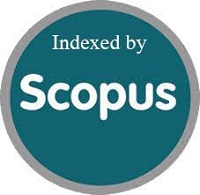Studi Tentang Dampak Dari Multidimensionalitas Butir Soal Terhadap Estimasi True Skor Dengan Pendekatan Model Bifaktor
DOI:
https://doi.org/10.15408/jp3i.v3i3.10732Keywords:
model bifaktor, unidimensiAbstract
Penelitian ini merupakan penelitian simulasi dimana yang menjadi fokus dalam penelitian ini adalah banyaknya faktor, item dan responden dengan replikasi 50 kali. Selanjutnya data hasil replikasi ini dianggap sebagai unidimensi dan bifaktor dan dihitung pengaruhnya dari selisih theta tersebut. Penelitian ini bertujuan untuk dapat mengetahui banyaknya faktor, item dan responden yang ikut terukur berdampak pelanggaran asumsi unidimensi pada bifaktor. Serta mengetahui perbedaan bias pada data bifaktor yang dianggap sebagai unidimensi tersebut. Hasil penelitian ini menunjukkan bahwa data dengan model bifaktor dan dianalisis sebagai unidimensi maka hasilnya akan memperoleh theta yang tidak sebenarnya, karena perbedaan bias atau deviasi yang terjadi cukup tinggi. Disamping berdasarkan hasil perhitungan didapatkan R square sebesar 0.69%, bias responden yang dapat dijelaskan oleh bervariasinya faktor, item dan responden dengan taraf signifikansi 0.000.
References
Axelrod, Robert. (2005). Advancing the art of simulation in the social sciences. University of Michigan. USA
Chen, Fang Fang, Yiming Jing, Adele Hayes, Jeong Min Lee. (2013) Tw o c o n c e p t s o r t w o approacches. A bifaktor analysis of psychological and s u b j e c t i v e w e l l - b e i n g . Department of Psychology. University of Dellaware, Wolf Hall, USA.
Chen, Fang Fang, West, Steephen and Sousa, Karen.( 2006). Acomparison of bifactor and second order models of quality of life. Multivariate B e h a v i o r a l R e s e a r c h . L a w r e n c e E r l b a u m Associates.
Embretson, S. E. & Reise, S. P. (2000). Item response theory for psychologist. New Jersey: L a w r e n c e E r l b a u m Associates. Inc
Fung, C. (2012). Ability estimation u n d e r d i f f e r e n t i t e m parameterization and scoring m o d e l s . D i s s e r t a t i o n , University of North Texas
Gignac, Gilles & Watkins, Marley. (2013). Bifaktor modelingand the estimation of model-based reliability in the WAIS-IV. Multivariate Behavioral R e s e a r c h , 4 8 : 3 9 - 6 6 2 . Routledge.
Han dan Hambleton. (2007). User's manual for wingen: windows software that generates IRT model parameters and item responses. University of Massachusetts Amherst.
Hambleton, R.K., Swaminathan, H & R o g e r s , J H . ( 1 9 9 1 ) . F u n d a m e n t a l s o f i t e m responses theory . California: SAGE Publications.
Hawell, Michael, Stone, Clement, Tse-Chi Hsu and Levent Kirisci (1996) Monte carlo studies in i t e m re s p o n s e t h e o r y . University of Pittsburgh. Psychological Measurement vol.20 n0.2, June 1996.
Jenrich, Robert dan Bentler, Peter. (2011). Exploratory bi-faktor analysis. National Institute Of Helath Public Access. Jurnal Psychometrika, Oktober 2011
Kroopnick, Marc Howard. (2010). Exploring unidimensional proficiency classification a c c u r a c y f r o m multidimensional data in a vertical scaling context. Disertasi dari University of Maryland, College Park.
Mislevy, R.J & Block, R.D. (1990).
BILOG 3: Item analysis & test scoring with binary logistic m o d e l s . M o o r s e v i l l e : Scientific Software, Inc.
Mundform, Daniel J.; Schaffer, Jay; Kim, Myoung-Jin; Shaw, D a l e ; T h o n g t e e r a p a r p , A m p a i ; a n d S u p a w a n , Pornsin (2011) "Number of Replications Required in Monte Carlo Simulation
Studies: A Synthesis of Four Studies," Journal of Modern Applied Statistical Methods: Vol. 10: Iss. 1, Article 4.
Muthen,& Muthen. (2010). Statistical analysis with latent variables user's guiden. Los Angeles.
Paxton, Pamela. Et all. (2001). Monte carlo experiments: design and implementation. Structural E q u a t i o n M o d e l i n g . L a w r e n c e E r l b a u m Associates, Inc.
Reise, Steven. (2012). The rediscovery of bifaktor measurement models. Jurnal Multivariate Behavioral Research. Oct. 2012. Vol 47.
Raychaudhuri, Samik (2008) . Introduction to monte carlo simulation. Proceedings of the 2008 Winter Simulation Conference. USA
Retnawati, Heri. (2008). Estimasi e f i s i e n s i r e l a t i f t e s berdasarkan teori respons butir dan teori tes klasik. D i s e r t a s i . Yo g y a k a r t a : P r o g r a m P a s c a s a r j a n a U n i v e r s i t a s N e g e r i Yogyakarta.
Simon, Mayuko Kanada. (2008).Comparison of concurrent a n d s e p a r a t e m u l t i d i m e n s i o n a l I R T lingking of item parameters. University of Minnesota. Tesis.
Sinharay, dan Haberman. (2010). Reporting of subscores using m u l d i m e n s i o n a l i t e m response theory. Jurnal Psikometrika col. 75.no. 2 hal. 209-227
Seranno, Daniel. (2010). A second order growth model for longitudinal item response data. Disertasi University of Nourth Carolina
Umar, Jahja. (2012a). Penilaian & peningkatan mutu pendidikan di Indonesia. Ciputat: UIN
Press
Umar, Jahja. (2012b). Mengenal lebih dekat konsep reliabilitas skor tes. Jurnal Pengukuran Psikologi dan Pendidikan Indonesia. April. 2012. Vol.II
Widhiarso, Wahyu. (2011). Teori pengukuran. Bahan Materi Fakultas Psikologi UGM



